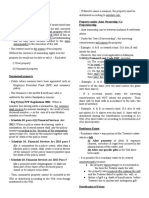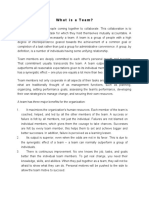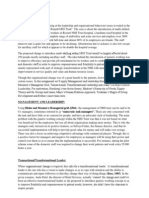Review of Goal Setting Theory
Review of Goal Setting Theory
Uploaded by
Randula ChandrarathneCopyright:
Available Formats
Review of Goal Setting Theory
Review of Goal Setting Theory
Uploaded by
Randula ChandrarathneCopyright
Available Formats
Share this document
Did you find this document useful?
Is this content inappropriate?
Copyright:
Available Formats
Review of Goal Setting Theory
Review of Goal Setting Theory
Uploaded by
Randula ChandrarathneCopyright:
Available Formats
REVIEW OF GOAL SETTING THEORIES
REVIEW OF GOAL SETTING THEORIES
(Assignment 02)
REVIEW OF GOAL SETTING THEORIES
Acknowledgement
Our Sincere gratitude to Mr. Buddhika Hewawasam for the support and direction provided to us within the class room, for spending time to clear our queries and doubts and constantly emphasizing to think beyond.
REVIEW OF GOAL SETTING THEORIES
Table of Contents
Abstract 1.0 Introduction 2.0 Business Issue 3.0 Literature Review Goal Setting in Theory 3.1 Management by Objectives 4.0 Goal Setting in Reality 4.1 A Success Story Hemas Consumer 4.2 Another Story Telecommunication Company 5.0 Critical Thoughts 6.0 Conclusion 03 04 05 06 06 07 07 09 11 14
REVIEW OF GOAL SETTING THEORIES
Abstract
In this report, we are trying to critically analyze the practical scenario versus the theories which we learn in the MBA class room. We have taken goal setting theory as the theory or the management tool and highlighted the present management context in using such theories. Also we have identified two companies who use goal setting theory to cascade down their corporate objectives starting from their Vision and Mission. But our question was are these exercises successful in real world and do the tactical level employees feel the responsibility through these exercises. The analysis of how these two companies, specifically from FMCG manufacturing industry and telecommunication industry, perform their goal setting activity and the results are incorporated in this report. According to the contemporary management theories we learnt in the class, we have critically analyzed this impracticality of goal setting theory in the present context.
REVIEW OF GOAL SETTING THEORIES
1.0 Introduction
The changing global business context has brought about an uncertain environment for organizations and become vital for firms to monitor all activities in order to sustain, stabilize and grow. To face challenges in present environment, managers are very much keen on how to handle the factors of production in effective manner. Hence objectives and goals have come to play a critical role in the operations of contemporary businesses. How are goals set? Has goal setting led organizations to success? Is it a new phenomenon in the management history? This reports objective is to address the above mentioned concerns of goal setting theory and critically analyze issues relating to goal setting. How do they relate to the theories learned in the class room?
REVIEW OF GOAL SETTING THEORIES
2.0 Business Issue
Organizations adopt contemporary management practices assuming that those would facilitate productivity and quality enhancements as well as cut down on their inefficiencies and earn better margins. Out of these best practices one of the most common practice is usage of balanced score card or Hoshin Kanri derived from Japanese management concepts to set organizational objectives and cascade them down to bottom levels. The issue at hand is how organisations have adapted and moved into a goal setting culture and to what extent are these theoretical objective setting processes practical? What are the outcomes of this process? Is it at benefit to the employees, the society at large its consumers or to the organisation and its profit making stakeholders? Does each and every employee receive goals, are they monitored or is it just merely a process thats part of all other processes in the organisation.
REVIEW OF GOAL SETTING THEORIES
3.0 Literature Review Goal Setting in Theory
Several Goal Setting theories are in practice in todays organizations. Goal setting theory, Management By Objectives (MBO) and the Balance Score Card are some of the most used and successful applications of goal alignments. But for the purpose of this report the focus will only be on the Management by objective theory. 3.1 Management by Objectives Management by Objectives (MBO) is a goal-oriented management tool in which managers and employees come together to agree upon a set of objectives to achieve for the company's short-, medium-, or long-term future. Management by objectives is a multi-step process in which previous goals are periodically evaluated and changed with employee input, then put into practice with performance evaluation and rewards to high achievers. In MBO also the goals are expected to be explicitly defined by the SMART Principle. Critics of management by objectives argue that the tool only works when goals are defined more specifically than is usually possible. Proponents argue that this arrangement helps employees avoid a workaday mentality in which activities are performed without any reference to greater objectives.
REVIEW OF GOAL SETTING THEORIES
4.0 Goal Setting in Reality
Two real world examples on how goal setting behaves in practice 4.1 A Success story Management by Objectives is used by many organizations but not all organizations achieve the same degree of success in using this theory. Hemas Consumer Brands is one organization which has successfully implemented the concept and indicating strong results. Hemas is a group of companies focusing on 5 sectors (namely FMCG, Healthcare, Transportation, Leisure and Strategic Investments). At the beginning of each year the Managing Director the respective sector is given the goals which are decided by the board of directors of the Hemas Holdings PLC. Goals received by each MD are later discussed with the directors of each sector and formulate plans for the next financial year. For example if the goal is to achieve 10% growth in the sector all the head of the departments or the directors are given goals to achieve the top most goal. These goals are the vital aspects of the MBO system. Goals at middle level of management are consistent with those at top levels. Goals of first line employees are related to those at middle levels. Hemas always believe that all goals must relate to and support the long term objectives and the overall company. They have categorized the goals of the managers to different areas such as (1). Regular work goals, (2). Problem solving goals, (3).Innovative goals,
(4) Development goals
REVIEW OF GOAL SETTING THEORIES
Example of goals linked to each levels of management
The figure above provides the goal cascading procedure in the FMCG sector. To further elaborate the concept we have chosen the Supply Chain function. There are several departments coming under the supply chain i.e. purchasing, logistics, production and maintenance. Each department is headed by a manager. Goals of the Supply Chain Director are cascaded down to the manager level and each manager sets goals to his subordinates based on the goals given to him. Every manger has to present the progress of the goals to the Supply Chain director on a weekly basis. If the progress is below the set goals, then the barriers are identified and are immediately rectified. Each employee gets five and eight goals enough to cover all the aspects of the job crucial to successful performance and certain weight is given to each goal depending on the importance of the goal. These goals are directly linked to the performance evaluation. As the annual salary increments and promotions are based on the performance evaluation each employee is keen on achieving the goals.
REVIEW OF GOAL SETTING THEORIES
10
There are several reasons which has made the concept of management by objectives success at Hema.. One main reason is the active involvement of the top management in the total process. Also MBOs are not set in a crash program. Quality time is spent with each individual in setting goals. Goals are discussed and agreed by the both parties at the beginning of the year. Regular reviews and linkage to the performance evaluation always play big role in the success implementation of the concept at Hemas Consumer Brands. 4.2 Another Story Following is the situation in one of the pioneer company in telecommunication industry. The goal setting procedure starts 2-3 months in advance of a new year, and the company uses a mix of decentralized planning & Management By Objectives. The Board of Directors and the CEO decides the annual turnover for a specific year, and then CEO meets all the Chief Officers and makes the necessary plans in detail. Then all the Chief officers (Network, Marketing, IT, HR, Strategic plans, Administration etc) present their plans for the year to all the Executive staff of the company. In addition regional awareness programs are conducted for other staff. As described by the MBO, Chief Officers set the targets for their immediate subordinates and these targets are cascaded down to the bottom. Then the achieving of targets monthly monitored, biannually reviewed and a more weight is given to these achievements at the annual performance approval. The most important aspect of this procedure is strategic planning. Though they do not have a very strong Research & Development unit, the strategic decisions are made considering the strengths and weaknesses of both the company and the competitors, customer requirements and the global trends. Another important factor is that the low resistance to change with the market conditions. The increasing involvement of people for goal setting (Decentralized Planning) and the introduction of Pay-for-Performance are another two positive aspects. These aspects are the application of theories into practice.
REVIEW OF GOAL SETTING THEORIES
11
As per the goal setting theory the goals should be aligned with Vision & Mission and these goals to be communicated throughout the company. But here the Vision & Mission is more focused on customers, but every year the strategic plan is prepared according to a theme prepared for that specific year. Sometimes it is very difficult to find out the relationship between this theme and the Mission of the company. Therefore the employees are not focused on the Vision & Mission. The biggest barrier that creates difficulties for applying theories into practice is the personal interests. The impact of this barrier is very high. For instance, before attending to the ABP preparation with the CEO, all the Chief Officers should have conducted meetings with the respective line managers to gather valuable ideas from all employee levels.( as per the Decentralized Planning method). But in practice the depth of collecting ideas from subordinates depends with the relevant Chief Officer. As there is no controlling method for this personal behavior, there is a high probability of implementing improper decisions. Software or Suppliers for technological improvements in the switching system) As per MBO, the employees should be motivated by mutually agreed SMART goals. But at the very beginning of the target setting procedure, employees get de-motivated as there is no such a mutually agreed, SMART goals in practice. Text Books & MBAs can provide many theories, but these theories are not strong enough to change cultures and behaviors of human beings. The best practice in the worlds best company definitely will not be applicable to another culture, though theories are normally generalized. Another key factor to be discussed in goal setting is the effectiveness of performance appraisal system. The target setting at the operational is not common all over the company. Sometimes it is very difficult to align organizational goals with some designations. Due to these reasons it is extremely difficult to set SMART goals. Consequently transparency cannot be maintained, and at the end of the year performance employees are not evaluated against the accomplishment. When the number of employees are very high in the operational level with hundreds of operational managers, the central HR system is not efficient enough to maintain a proper appraisal system. In addition there are other external factors hindering the application of theories into practice. Some of them are government regulations and influences, trade union actions, abrupt company policy changes etc. (Ex. Selecting
REVIEW OF GOAL SETTING THEORIES
12
5.0 Critical Thoughts
Many theories of famous gurus have come to the helping hand of organisational management, but to what extent have they been understood these concepts from the era they were introduced to the world. Can they be still applicable as it is? Given below is a comparison of todays goal setting theories with Fredrick Taylors Scientific Management approach. Taylorism has been selected because it was the seed to many theories of management. 4.1 Fredrick Taylors Scientific Management: Taylor in his scientific management approach introduced a management style that compensated employees by the no of hours they worked. The first seed for goal setting theories. Even though the larger focus of Taylorism is on economic efficiency and waste reduction current goal setting theories have been developed on the basis of enhancing individual performance and appraising employees based on their performance. Todays goal setting theories have budded from Taylors approach and is now highly developed and modernised. Similarities between Scientific Management approach and current goal alignment theories 1. They both focus on performance based compensation 2. Ensures productivity. Taylor encourages more labour hours where as MBO, Balance Score Card method, goal setting theories ensures the particular responsibility is given to the employee in order to achieve individual and organisational goals. 3. Waste management: Taylor focuses on the wastage of time, money and effort where as modern goal alignment theories also focus on the same by providing individual responsibilities and ensuring the individual attention is only on achieving the given responsibilities in the given time frame with the allocated resources. A modern form of Taylorism in the disguise as goal alignment and pay for performance. 4. Division of labour: Similar to Taylors approach current goal alignment theories also ensures who is responsible for what and how it is to be done? A developed form of Taylors division of labour. 5. Motivating employees towards better compensation and benefits for hard work and better performance
REVIEW OF GOAL SETTING THEORIES
13
Differences between Scientific Management and current goal alignment theories Scientific managements larger focus was only on increasing productivity and waste reduction whereas goal alignment theories focus on 1. Achieving the organisational goal, which are beyond financial goals and productivity / operational goals. In addition to the financial and productivity goals organisations focus is also on the corporate establishment as socially responsible organisations, a better place to work, strong brand equity and on organisational values. 2. Enables a work culture that is equal to all by providing performance evaluation on similar grounds. 3. Ensuring the contribution of each and every employee towards the organisational goals by providing the responsibility towards the larger goals 4. Systematic operations by sharing of responsibilities 5. Ability to monitor process, productivity and performance and rectifying any deviations from the set goals So the question arises if all organisations that follow such goal alignment theories successful? Not necessarily. This is due to many reasons. Some of which are discussed below Many organisations initiate goal setting but do not follow up and continue the follow up process of goal alignment. For example the balance score card (BSC) method encourages constant review of the set goals but in reality do all organisations that have adapted BSC review their performance in the given time durations? Many organisations are highly active and enthusiastic at the time of goal setting but the same level of enthusiasm does not continue throughout the year. It is only a process that needs to be show cased to their stakeholders. (ie: board members, parent company, to be attractive in the labour market) Top-management commitment is a crucial part of this process. Current CEOs are under pressure to show performance and growth of the overall company rather than how and where it was achieved. Again this is only a one view and does not conclude for all the corporate heads.
REVIEW OF GOAL SETTING THEORIES
14
This does not necessarily mean that there arent any organisations that have successfully implemented these theories. As mentioned in the above section Hemas is highly focused on their goal alignment process. The corporate goals cascade down to each and every employee and is monitored on a quarterly basis.
REVIEW OF GOAL SETTING THEORIES
15
6.0 Conclusion
We can conclude that many companies adopt goal setting theory and some are successful and some are not. Major reasons behind being unsuccessful is not having top management commitment, no proper follow up, lack of enthusiasm, doing it only to show up to top management, lack of allocated resources and planning. But some companies like Hemas FMCG have proven that the goal setting activity can be practically done and it would enhance the company overall productivity, quality and efficiencies. On the other hand majority of the companies fail in this activity due to many reasons as highlighted above.
You might also like
- Tourism Operations ManagementDocument12 pagesTourism Operations ManagementMarieNo ratings yet
- Data and InformationDocument15 pagesData and InformationrburtonshawNo ratings yet
- Talent-Factsheet Cipd Nov 21Document8 pagesTalent-Factsheet Cipd Nov 21Klayton MonteverdeNo ratings yet
- Topic 4: Estate and BeneficiariesDocument9 pagesTopic 4: Estate and BeneficiariesLEANDRA ABIGAIL DE COSTANo ratings yet
- Management Development: Incorporated by Royal Charter, Registered Charity No. 1079797 123Document9 pagesManagement Development: Incorporated by Royal Charter, Registered Charity No. 1079797 123Abdulaziz AlzahraniNo ratings yet
- Performance AppraisalDocument41 pagesPerformance AppraisalRucha AmbetkarNo ratings yet
- Agreement To Sell Plot / HouseDocument2 pagesAgreement To Sell Plot / HouseMore Ideas50% (2)
- Assignment 1 Organisational Behaviour 0911Document7 pagesAssignment 1 Organisational Behaviour 0911Joe HizulNo ratings yet
- Training and DevelopmentDocument5 pagesTraining and DevelopmentAlif AnasNo ratings yet
- Organisational BehaviourDocument53 pagesOrganisational BehaviourVimal KanthNo ratings yet
- Performance AppraisalDocument20 pagesPerformance AppraisalGODBARNo ratings yet
- Introduction To Management Unit 1Document47 pagesIntroduction To Management Unit 1roberaakNo ratings yet
- Collaboration PresentationDocument14 pagesCollaboration Presentationapi-276598737100% (1)
- THC3 - From Module 3 To 5Document9 pagesTHC3 - From Module 3 To 5Camille AdarnaNo ratings yet
- What Is A Team?Document10 pagesWhat Is A Team?vandanagahlot100% (1)
- Impact of Cultural Differences On Merger and Acquisition Performance - A Critical Research Review and An Integrative ModelDocument32 pagesImpact of Cultural Differences On Merger and Acquisition Performance - A Critical Research Review and An Integrative ModelNavleen Kaur100% (1)
- BASIC COMPETENCY 2 - Work-in-Team-Environment... FINALDocument27 pagesBASIC COMPETENCY 2 - Work-in-Team-Environment... FINALmark anthony banasanNo ratings yet
- Total Quality ManagementDocument6 pagesTotal Quality ManagementSahaa NandhuNo ratings yet
- Develop Teams & Individuals - Doc3Document40 pagesDevelop Teams & Individuals - Doc3FelekePhiliphos100% (3)
- Which Leadership Type Is The Most Effective Transformational Transactional Taskfocused or People-FocusedDocument1 pageWhich Leadership Type Is The Most Effective Transformational Transactional Taskfocused or People-FocusedAlicjaONo ratings yet
- Performance AppraisalsDocument5 pagesPerformance AppraisalsSubhajit MukherjeeNo ratings yet
- TrainingDocument31 pagesTrainingNataliaMartianNo ratings yet
- Goal SettingDocument4 pagesGoal SettingSruthy KrishnaNo ratings yet
- Blake Mouton Managerial GridDocument5 pagesBlake Mouton Managerial Gridfaqieha athilahNo ratings yet
- M1.Intro To Hospitality 1Document8 pagesM1.Intro To Hospitality 1Maribelle JojoNo ratings yet
- The Line ManagerDocument19 pagesThe Line ManagerAamer Ahmed ChowdhuryNo ratings yet
- Induction and OrientationDocument19 pagesInduction and OrientationPrajot Morajkar100% (3)
- How To Improve Your Leadership SkillsDocument6 pagesHow To Improve Your Leadership SkillsLeen ZainNo ratings yet
- Annex3 CSR Framework QuestionnaireDocument25 pagesAnnex3 CSR Framework QuestionnaireAshishh KhadseNo ratings yet
- Performance Appraisal and Its ProcessDocument7 pagesPerformance Appraisal and Its Processraunak jhaNo ratings yet
- Nesperos Food and Beverage Operational ControlDocument6 pagesNesperos Food and Beverage Operational ControlRoanBronolaSumalinogNo ratings yet
- Managing Quality and Developing PerformanceDocument25 pagesManaging Quality and Developing PerformancemiffypangNo ratings yet
- Training Effectiveness and Transfer - A Mixed Methods InvestigationDocument22 pagesTraining Effectiveness and Transfer - A Mixed Methods InvestigationGreg LopezNo ratings yet
- Management TeamDocument39 pagesManagement TeamHatem FaragNo ratings yet
- Cooperate Social ResponsibiltyDocument15 pagesCooperate Social ResponsibiltyMuhammedAnsariKodappanakkalNo ratings yet
- Managerial FunctionsDocument14 pagesManagerial FunctionskasuNo ratings yet
- Level 5 5013v1 Exemplar Assignment 2 For WebsiteDocument5 pagesLevel 5 5013v1 Exemplar Assignment 2 For WebsiteKareemAdams902950% (2)
- Mind MapsDocument5 pagesMind MapsRaziq100% (1)
- Mba in Retail Management Course ContentDocument29 pagesMba in Retail Management Course ContentAkhil RajNo ratings yet
- Primary and Secondary ResearchDocument3 pagesPrimary and Secondary Researchapi-535005301No ratings yet
- OD Practicioner Job DescriptionDocument3 pagesOD Practicioner Job DescriptionGerald AbergosNo ratings yet
- Training and Development Notes Unit 2Document16 pagesTraining and Development Notes Unit 2Prabhat ThakurNo ratings yet
- Rosete and Ciarrochi 2005 Lodj EI Leadership EffectivenessDocument34 pagesRosete and Ciarrochi 2005 Lodj EI Leadership EffectivenessAdrian MoiseNo ratings yet
- CS Establish & Maintain A Bus Relationship 051011Document7 pagesCS Establish & Maintain A Bus Relationship 051011Nette de GuzmanNo ratings yet
- Resourse AllocationDocument10 pagesResourse Allocationindra singhNo ratings yet
- Assignment 2Document7 pagesAssignment 2Anum ImranNo ratings yet
- Transformational LeadershipDocument28 pagesTransformational LeadershipSumaira BilalNo ratings yet
- Rater Training ProgramsDocument3 pagesRater Training Programsdua fatimaNo ratings yet
- Pest AnalysisDocument15 pagesPest AnalysisUthpala KinivitaNo ratings yet
- Assignment Business Communication Skills (Mba I ST Semester) (Section A)Document14 pagesAssignment Business Communication Skills (Mba I ST Semester) (Section A)Karan HansNo ratings yet
- Definition of TrainingDocument18 pagesDefinition of TrainingTyagi Munda AnkushNo ratings yet
- Evaluation of Training Company)Document57 pagesEvaluation of Training Company)Archana ManeNo ratings yet
- Quality Service ManagementDocument35 pagesQuality Service ManagementenriqueterronesNo ratings yet
- Operations Management Chapter 1-5Document68 pagesOperations Management Chapter 1-5Edwins GajanaNo ratings yet
- Specialty Food and Beverage - A Case Study of Small Business ManagDocument11 pagesSpecialty Food and Beverage - A Case Study of Small Business ManagUmi MakiNo ratings yet
- Job Characteristics ModelDocument3 pagesJob Characteristics ModelMyla Rose AcobaNo ratings yet
- Ed Ebreo - Service Excellence WorkshopDocument5 pagesEd Ebreo - Service Excellence WorkshopEdwin EbreoNo ratings yet
- Defining LeadershipDocument19 pagesDefining Leadershipapi-313921764No ratings yet
- High Performance Work System ArticleDocument15 pagesHigh Performance Work System ArticleDr-Tarek HassanNo ratings yet
- CHAPTER-9 Strategy Implementation and ChangeDocument11 pagesCHAPTER-9 Strategy Implementation and ChangeJe GregorioNo ratings yet
- Human Performance Technology A Complete Guide - 2020 EditionFrom EverandHuman Performance Technology A Complete Guide - 2020 EditionNo ratings yet
- The Flatmates: Quiz: Reported SpeechDocument4 pagesThe Flatmates: Quiz: Reported SpeechAjdin MemisevicNo ratings yet
- Ron Brookmeyer, Donna F. Stroup-Monitoring The Health of Populations - Statistical Principles and Methods For Public Health Surveillance (2003)Document389 pagesRon Brookmeyer, Donna F. Stroup-Monitoring The Health of Populations - Statistical Principles and Methods For Public Health Surveillance (2003)Medical_Doctor100% (1)
- Daily Technical Analysis - 29 April 2024Document9 pagesDaily Technical Analysis - 29 April 2024Merry julianaNo ratings yet
- Class 10th Chapter 1 ScienceDocument52 pagesClass 10th Chapter 1 SciencerudrakshthadhaniNo ratings yet
- Monitoring Job and InflationDocument12 pagesMonitoring Job and InflationTahreem KhanNo ratings yet
- The IBE Business Ethics Framework - Institute of Business Ethics - IBEDocument5 pagesThe IBE Business Ethics Framework - Institute of Business Ethics - IBEmadNo ratings yet
- A & A Report Writing NotesDocument53 pagesA & A Report Writing NotesEshet ShumetNo ratings yet
- Presence of Mind and Communication Skills of Dr. C. N. AnnaduraiDocument10 pagesPresence of Mind and Communication Skills of Dr. C. N. AnnaduraiNihal AshikNo ratings yet
- Leon Gto EnglishDocument9 pagesLeon Gto EnglishMaximiliano Muñoz AmezquitaNo ratings yet
- Lesson 2 Introduction To Principles of Web DesignDocument5 pagesLesson 2 Introduction To Principles of Web DesignDavid KimathiNo ratings yet
- Home Budget PlannerDocument137 pagesHome Budget Plannerjiguparmar1516No ratings yet
- CBMC Solution 2020-21Document19 pagesCBMC Solution 2020-21Prerna AgrawalNo ratings yet
- Catalogue Indirect MeteringDocument4 pagesCatalogue Indirect MeteringCata ComanNo ratings yet
- ENGLISH LEARNING MODULE - KardinawatiDocument28 pagesENGLISH LEARNING MODULE - KardinawatiKardina watiNo ratings yet
- Pertemuan 7 Fungsi ProduksiDocument19 pagesPertemuan 7 Fungsi ProduksiCanderaNo ratings yet
- MG4C2 (2023-24) Lecture 11 Handout - SLIDES (Org Culture)Document30 pagesMG4C2 (2023-24) Lecture 11 Handout - SLIDES (Org Culture)Rashmi SinghNo ratings yet
- LIFE3 0-24oct20Document21 pagesLIFE3 0-24oct20Nina CR100% (1)
- Bi 501 03 Final Imdb RatingDocument33 pagesBi 501 03 Final Imdb Ratingapi-301041320No ratings yet
- 45350news 12062022120344Document2 pages45350news 12062022120344PranjalNo ratings yet
- Activity 1 DIASSDocument3 pagesActivity 1 DIASSLJ FamatiganNo ratings yet
- BusinessWorld 6 27 2012Document23 pagesBusinessWorld 6 27 2012Cedric John AmolozaNo ratings yet
- SBU Memory Aid (Bill of Rights)Document23 pagesSBU Memory Aid (Bill of Rights)rosalie.luarezNo ratings yet
- Vibhuti PadaDocument50 pagesVibhuti PadaAnkit LatiyanNo ratings yet
- Hydroponics Lecture NotesDocument61 pagesHydroponics Lecture NotesNarendra jaiswalNo ratings yet
- Plan Aws Solutions ArchitechtDocument5 pagesPlan Aws Solutions Architechtaimenlechekhab15No ratings yet
- Abstract Full Paper - Education and National Integration Indian PerspectiveDocument6 pagesAbstract Full Paper - Education and National Integration Indian PerspectiveAbhishek MatNo ratings yet
- Descifrar El VINDocument5 pagesDescifrar El VINSAYFUDDINSG100% (1)
- MICRO LESSON PLAN (Entrepreneurship)Document2 pagesMICRO LESSON PLAN (Entrepreneurship)musthakmechNo ratings yet

























































































